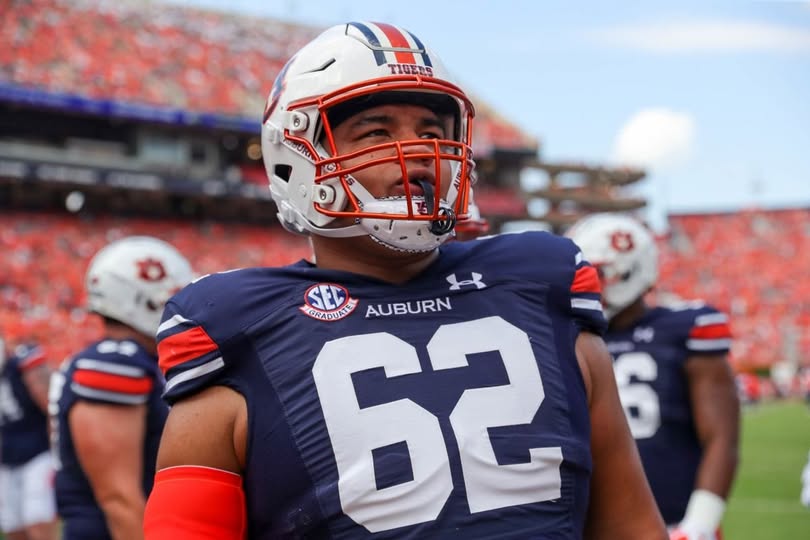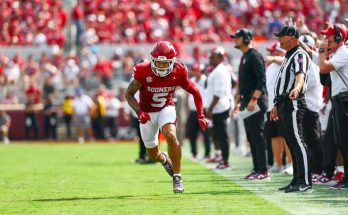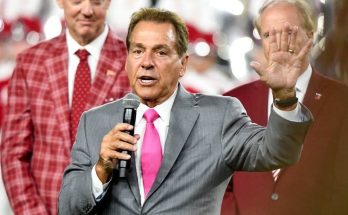Auburn’s experienced offensive line enters 2025 as the fulcrum of the Tigers’ ambitious return to national relevance. Under the stewardship of head coach Hugh Freeze and line coach Jake Thornton, what was once a revolving door of uncertainty has been recast into a stable, powerful core defined by veteran leadership and depth. With 140-plus career starts returning along with two big-time portal additions, Auburn’s trenches may now be the most formidable unit on The Plains—a foundational muscle to drive a breakthrough season.
Breaking down the revamped line, we find an impressive blend of SEC-seasoned returnees and game-ready newcomers. Inside, returning starters center Connor Lew, left guard Dillon Wade, and right guard Jeremiah Wright anchor the interior. Over on the edges, veterans Izavion “Too Tall” Miller and the incoming dual-tackle tandem of Xavier Chaplin and Mason Murphy add both stability and elite-level athleticism.
Lew, a 6‑foot‑3 Sophomore center from Kennesaw Mountain, took the reins in 2023 following an injury to Avery Jones and held the starting spot throughout 2024. Named to the SEC All-Freshman team and praised as “an NFL center” by Freeze, Lew played a staggering 748 snaps in ’23 . His steady intelligence and leadership on the line make him the undeniable lynchpin in both run and pass schemes. Thornton emphasized Lew’s role as critical for bringing cohesion to the entire unit .
Flanking Lew is Dillon Wade at left guard—a 6‑3 senior with 36 career starts, including transfers from Tulsa. Wade moved from tackle to guard in 2024 and has shown marked improvement in road grading from PFF . His experience bolsters the middle, allowing Auburn to run downhill with physicality.
On the right guard spot, Jeremiah Wright returns as a team captain and senior anchor. A former defensive player turned OL standout, Wright started all 12 games in 2024 and carries a reputation for “nasty” physicality and brute strength in the run game . AFC scouts have noted his run-blocking and snapping instincts, and his presence promises discipline and consistency between the tackles.
Rounding out the interior depth are redshirt sophomore Dylan Senda, promising freshman DeAndre Carter, and incoming signee Kail Ellis—all ready to step in if rotation is needed. The competition for breathers in an SEC grind is far healthier than in years past.
The edge spots, however, may offer the most intrigue. Izavion “Too Tall” Miller returns at right tackle, bringing with him 24 career starts and a past SEC Lineman of the Week award . A 6‑5 junior-college transfer with enormous upside, Miller has been consistent but will face pressure from USC transfer Mason Murphy, a 6‑5, 320-pound veteran who started 22 games in four seasons in Los Angeles . Murphy’s polished technique and experience make him a likely challenger for the role.
On the other side, Auburn landed Virginia Tech transfer Xavier Chaplin, rated the No. 3 tackle in the portal by 247Sports. A 6‑7, 335-pound junior, Chaplin has 25 starts and earned all‑ACC honorable mention after a strong 2024 campaign . Athlon Sports praised the portal acquisition as transformative, asserting Auburn may deploy its “most talented front five in nearly a decade” (.
Behind the starters, the Tigers possess rare depth: Texas A&M JUCO transfer Seth Wilfred, freshman Broderick Shull, Tyler Johnson, and Favour Edwin all compete at tackle spots, giving Thornton flexibility to rotate and keep players fresh . Rivals even ranked Auburn’s tackle depth—Chaplin, Tyler Johnson, Broderick Shull—as a major spring strength .
What does all this mean on the field? For one, it suggests Auburn can run with authority in the SEC. The interior trio—Wade, Lew, Wright—is built for gap‑control aggression. Miller or Murphy on the right can countless times open lanes for tailbacks like Jarquez Hunter, who racked up over 1,200 yards in 2023 behind a porous line .
Moreover, pass protection becomes more viable. Lew’s snapping and reach are crucial in time-sensitive passing windows. Chaplin’s arm length and technique deter inside penetrators, and Murphy’s edge awareness curbs edge rushers . The rest of the offensive unit—new quarterback Jackson Arnold, a deep receiving corps, and tight end support—will all benefit if these protectors hold firm.
Depth also empowers strategy. Thornton has stated a belief that “competition breeds greatness… it takes years to build an O-line,” and Auburn finally has that competition across the board . Freshmen and backups get real reps in camp, and pressure situations in practice can simulate SEC-level destruction without wearing out starters.
That competitive environment safeguards from injuries—a chronic problem line units face. A wounded starter in years past would have exposed Auburn’s thin roster. Now, those backups are ready, seasoned by spring drills and battle-tested in rotation.
Leadership is another intangible strength. Lew, Wright, Miller, and Wade aren’t just performers—they’re voices. They set the tone in film sessions, in the weight room, and in the locker room. Freeze and Thornton rely on them to uphold toughness standards. External observers have already noted Wynn’s optimistic tone: Freeze mentioned “we’re excited” about the group, specifically calling out young talent and veteran backbone .
What does this portend for Auburn’s 2025 season? The potential is enormous. Should the line maintain cohesion, Auburn can develop a dual-threat offense—ground-and-pound with power, plus timely vertical shots. That’s the recipe to challenge team like Alabama, Georgia, Tennessee, and LSU.
Quarterback Jackson Arnold (ranked No. 7 among SEC QBs) needs pocket security; this unit provides it. Tailback runs depend on mauling openings; this depth promises them. The crowd noise advantage at Jordan-Hare becomes moot if defenders hesitate at the line.
And this is no projection. Sports Illustrated’s Terrance Biggs boldly previewed Auburn’s era of contention:
“Auburn’s offense stands on the precipice of being one of the conference’s best… By surrounding a talented leader in Connor Lew, Auburn sets in motion a foundation in which they will compete for conference titles sooner rather than later.”
Athlon echoed those sentiments: “may have their most talented front five in nearly a decade” .
Still, SEC trenches are unforgiving. The offensive line must hold up game after game, adapting to blitz schemes, mobile edge rushers, and physically brutal rushing fronts. Toughness will be tested, resilience rewarded.
Backing depth is key. A healthy offensive line enables power rotations and auditing. Auburn’s depth chart lists 18 linemen, with 16 likely to hit spring drills . That level of insurance is near-elite.
Recruiting has backed this up too. Auburn invested heavily in 2023–2025 classes, bringing in higher-graded freshmen like 4-star Tavaris Dice, Broderick Shull, and others with elite par. Rank comparisons show strong optimism in the pipeline .
Combine veterans holding the fort today, young talent pushing ahead tomorrow, and a coaching philosophy built on trench toughness—and you have a line built for breakout.
In sum, Auburn enters 2025 with its most convincing offensive line narrative since the Gene Chizik era. With 140+ career starts, SEC accolades, transfer portal answers, and a competition-fueled environment—these linemen can seize and sustain Alabama threats, fortify big-play offense, and anchor a season-worthy run.
For Auburn hopefuls, this unit embodies power, leadership, and depth. If it delivers on that promise, expect a season where the Tigers thunder through SEC and reach bowl contention—anchored by the upfront dominance that once made them feared.



